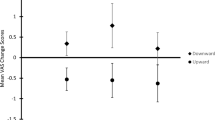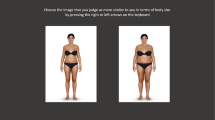Abstract
Adherence to an attractiveness ideal was considered as a possible mediator of a physique contrast effect among Caucasian women. Following exposure to photographs of models typifying idealized thin physiques, women displayed decreased self-esteem and increased self-consciousness, social physique anxiety, and body dissatisfaction. Although women with low adherence to an attractiveness ideal seemed to be advantaged by having greater self-esteem, less self-consciousness, and lower physique anxiety or dissatisfaction than their high adherence counterparts, these women did not display any unique resistance to the contrast effect. High affirmation of an attractiveness ideal was associated with exceptionally high potential for disordered eating. Eating disorder potential did not show influence of the contrast effect, but long-term implications were considered.
Similar content being viewed by others
REFERENCES
Brown, J. D., Novick, N. J., Lord, K. A., & Richards, J. M. (1992). When Gulliver travels: Social context, psychological closeness, and self-appraisals. Journal of Personality and Social Psychology, 62, 717–727.
Cash, T. F., Cash, D. W., & Butters, J. W. (1983). “Mirror, mirror, on the wall...?” Contrast effects and self-evaluations of physical attractiveness. Personality and Social Psychology Bulletin, 9, 351–358.
Fenigstein, A., Scheier, M., & Buss, A. (1975). Public and private self-consciousness: Assessment and theory. Journal of Consulting and Clinical Psychology, 43, 522–527.
Garner, D. M., & Garfinkel, P. E. (1982). The multidetermined nature of anorexia nervosa. In P. E. Garfinkel & D. M. Garner (Eds.), Anorexia nervosa: A multidimensional perspective. New York: Brunner-Mazel.
Garner, D. M., Olmsted, M. P., & Polivy, J. (1983). Development and validation of a multidimensional eating disorder inventory for anorexia nervosa and bulimia. International Journal of Eating Disorders, 2, 15–34.
Geiselman, R. E., Haight, N. A., & Kimata, L. G. (1984). Context effects on the perceived physical attractiveness of faces. Journal of Experimental Social Psychology, 20, 409–424.
Gordon, R. A. (1990). Anorexia and bulimia: Anatomy of a social epidemic. Cambridge, MA: Basil Blackwell.
Hart, E. A., Leary, M. R., & Rejeski, W. J. (1989). The measurement of social physique anxiety. Journal of Sport and Exercise Psychology, 11, 94–104.
Helmreich, R., Stapp, J., & Ervin, C. (1974). The Texas Social Behavior Inventory (TSBI): An objective measure of self-esteem or social competence. Journal Supplement Abstract Service. Catalog of Selected Documents in Psychology, 4, 79.
Irving, L. M. (1990). Mirror images: Effects of the standard of beauty on the self-and body-esteem of women exhibiting varying levels of bulimic symptoms. Journal of Social and Clinical Psychology, 9, 230–242.
Kenrick, D. T., & Gutierres, S. E. (1980). Contrast Effects and judgments of physical attractiveness: When beauty becomes a social problem. Journal of Personality and Social Psychology, 38, 131–140.
Nemeroff, C. J. (April, 1995). Bodies in the media: Emerging trends as reflected in magazine article content. Paper presented at the annual meeting of the Eastern Psychological Association, Boston, MA.
Polivy, J., Garner, D. M., & Garfinkel, P. E. (1986). Causes and consequences of the current preference for thin female physiques. In C. P. Herman, M. P. Zanna, & E. T. Higgins (Eds.), Physical appearance, stigma, and social behavior: The Ontario symposium (Vol. 3). Hillsdale, NJ: Lawrence Erlbaum.
Stice, E., Schupak-Neuberg, E., Shaw, H. E., & Stein, R. I. (1994). Relation of media exposure to eating disorder symptomatology: An examination of mediating mechanisms. Journal of Abnormal Psychology, 103, 836–840.
Stice, E., & Shaw, H. E. (1994). Adverse effects of the media portrayed thin-ideal on women and linkages to bulimic symptomatology. Journal of Social and Clinical Psychology, 13, 288–308.
Thornton, B., Leo, R., & Alberg, K. (1991). Gender role typing, the superwoman ideal, and the potential for eating disorders. Sex Roles, 25, 469–484.
Thornton, B., & Moore, S. (1993). Physical attractiveness contrast effect: Implications for self-esteem and evaluations of the social self. Personality and Social Psychology Bulletin, 19, 474–480.
Timko, C., Striegel-Moore, R. H., Silberstein, L. R., & Rodin, J. (1987). Femininity/masculinity and disordered eating in women: How are they related? International Journal of Eating Disorders, 6, 701–712.
Wiseman, C. V., Gray, J. J., Mosimann, & Ahrens, A.H. (1992). Cultural expectations of thinness in women: An update. International Journal of Eating Disorders, 11, 85–89.
Author information
Authors and Affiliations
Rights and permissions
About this article
Cite this article
Thornton, B., Maurice, J. Physique Contrast Effect: Adverse Impact of Idealized Body Images for Women. Sex Roles 37, 433–439 (1997). https://doi.org/10.1023/A:1025609624848
Issue Date:
DOI: https://doi.org/10.1023/A:1025609624848




